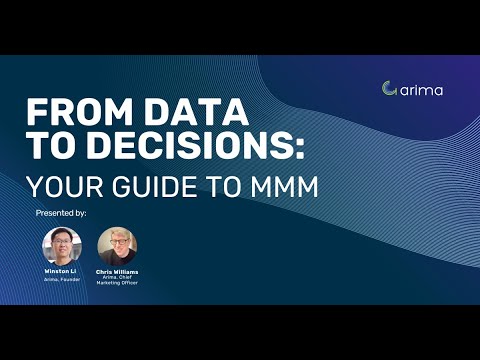Marketing Mix Modelling as the New Conversion Pixel

Nearly 30 years ago the digital ad server introduced the conversion pixel into measurement. This created a stream of data connecting digital media exposure and the advertiser's desired outcome. Advertisers loved it but wished they could do the same for all media. Now, Marketing Mix Modelling is replacing the conversion pixel as the way to connect media to business outcomes, and it works across all media. The implications of this shift are large and broad to the advertising media market.
The introduction of conversion pixels led to a massive shift in ad dollars that changed how media currencies work. Impressions became currency and audience was downgraded to a metric. Also, site choice became less important than buying performance or behavioral targets. Media currency became ad-served impressions that were targeted toward the desired audience, but no media vendor guaranteed reach against that audience. No GRPs or Cost per point, instead, cost per click, and cost per acquisition became additional media currencies, especially in ad networks and platforms. This allowed digital platforms to offer global products as impressions do not rely on local audience panel data and therefore no need to participate in a local Joint Industry Committee (JIC). Instead, the Media Rating Council became the de facto global standard body for the definition of impressions and accreditation of measuring technology.
The combination of media exposure and outcome metrics was enormously successful. Suddenly all media suppliers wanted to emulate a similar offering resulting in the proliferation of "Walled Gardens"; media operations that combined media planning, buying, and delivery with their 1st party data and outcome metrics. However, revenue growth within a walled garden is limited to the number of users within the walls of their gardens. Plus, marketers need to understand the duplication between walled gardens for media exposure, outcomes, and sales. The walled garden strategy benefits the media seller but creates problems for their customer - the marketer.
Marketing Mix Models solve the walled garden problem. They offer the full universe of all customers, all outcomes, and all media. First used in the 1950s, Marketing Mix Models were limited by expense, complexity, and lack of speed. In the last few years cloud computing has removed those limitations and is now taking the role previously held by conversion pixels. Open-source MMM code is now available from major digital platforms. Arima data offers live MMM on an easy to use SaaS basis. Additional data science derived from old-school direct marketing such as geographic A/B testing, matched markets, and geo-creative testing combined with MMM in cloud computing platforms create rich testing and optimization environments.
The result of Marketing Mix Models superseding conversion pixels is to drive platform development at the cross-media level instead of walled gardens and it will continue to challenge the role of panel-based JICs focused on one media type only. MMM's cross-media evaluation demands a cross-media audience defined on the advertiser's terms.
Recall, that there is no JIC for measurement of digital ads, and now digital includes the fast-growing connected TV ad-supported streamers along with other digital video platforms. Further advertisers are pushing their audience data to publishers, or using third-party data which eliminates the JIC's role in providing data about the audience seeing the ads. And much of this media is bought programmatically with the ad placed dynamically meaning measuring the content audience is not a proxy for the ad audience. This begs the question of what is the future role of JICs as this segment expands.
Will the media industry push towards a resurgent new type of JIC to handle cross-media and outcome measurement in a big data environment? Certainly, media standards, data quality, consistency, and repeatability are advertiser demands that are supportable from the sell side but only if the data is shared between buyer and seller. If media currency is just a bunch of impressions, then a different view is required. Cross-media outcome benchmarks measured through MMM and other big data approaches should be pursued by sellers so that they have a view of the value they produce as seen from the advertiser's perspective.
The conclusion is the future is grounded on MMM-based cross-media measurement. There are 6 implications that the media industry has to wrestle with:
- Impressions as currency, audience as metric. Changes in the market demands and roles of JICs.
- If JICs want a role in audience definitions, they need to extend their capabilities into the programmatic bid stream underpinning trading in addition to ad measurement.
- To align audience definition across business and cross-media planning, buying, and measurement, the JIC needs to enable advertiser-defined audience.
- Outcome measurement is more insightful than media currency in understanding the value media types create but outcome measurement is interdependent not siloed. Traditional JICs should see benchmark views into the advertiser's outcome metrics.
- Advertiser-defined audiences and outcome metrics operate across media types; cross media planning can't rely exclusively on syndicated panel data anymore. The traditional JIC that serves a single media type must feed into a new cross media/cross functional Super JIC.
- The super JIC needs to functionally merge media of different types, enable standard audiences in bid streams, and analyze advertiser outcomes to determine value and benchmarks. Strong technical capabilities in Marketing Mix Modelling and synthetic data use are required. As such, governance can be tri-partite however advertiser dominance is required
This article was written by Chris Williams who has 30 years experience in digital media. Previously, he was President IAB Canada and Vice President Digital at the Association of Canadian Advertisers. Now with a startup that offers live market mix models combined with consumer insight tools based on synthetic data and Virtual IDs.
Posted at MediaVillage through the Thought Leadership self-publishing platform.
Click the social buttons to share this story with colleagues and friends.
The opinions expressed here are the author's views and do not necessarily represent the views of MediaVillage.org/MyersBizNet.

